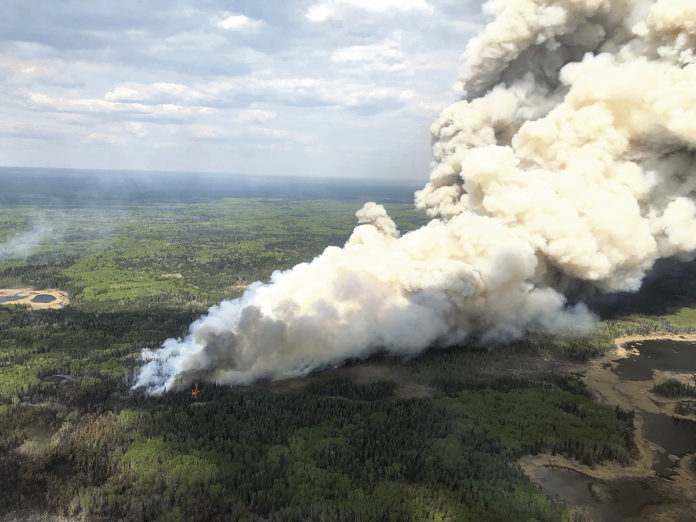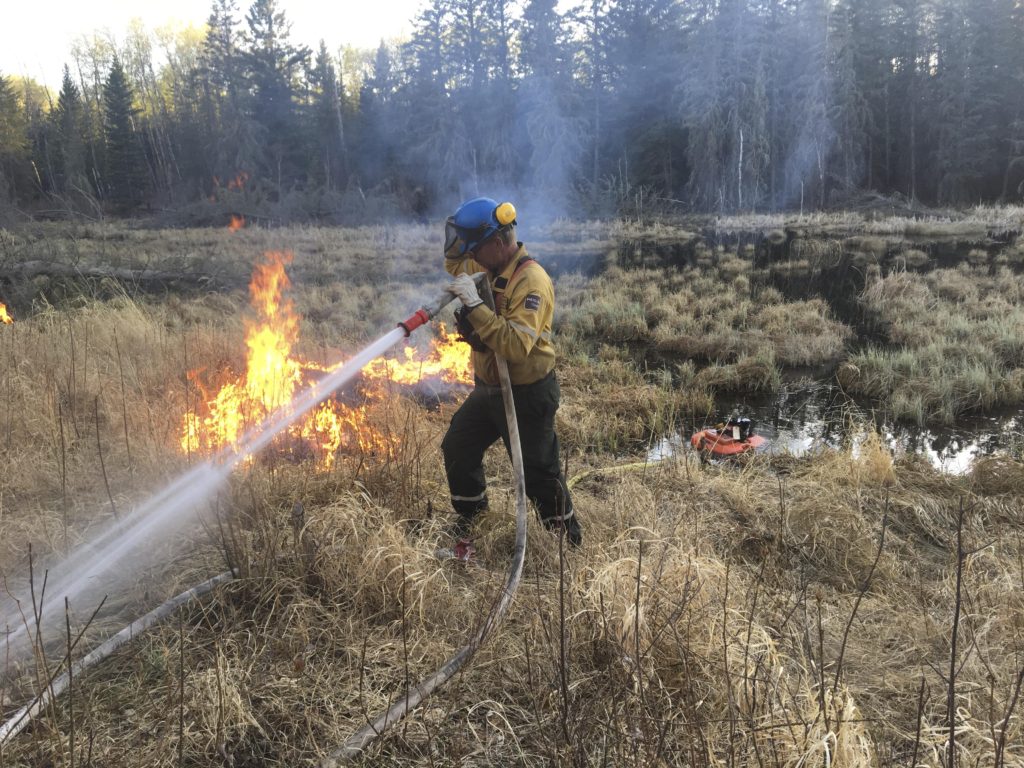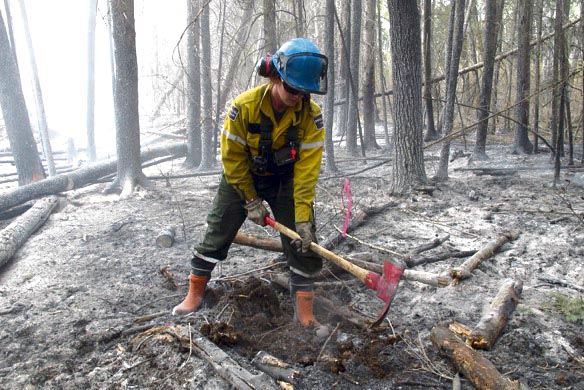
More details emerge about origin of a fire burning through Prince Albert National Park as crews struggle to contain it in some of the park’s most remote areas
The uncontained wildfire currently burning in Prince Albert National Park was sparked while crews were constructing control lines, and not from a prescribed fire itself, officials have said.
The revelation came during a media conference call held Thursday. According to park superintendent David Britton, a control fire spotted away from crews on May 6, eventually leading to the current wildfire, now listed at 31,400 hectares. Crews had been preparing the area since May 4. At the time crews started prescribed fire operations, there were no fire bans in place in the surrounding areas.
“We were constructing control lines. These are a narrow, burned perimeter we construct around the area we want to carry out the prescribed fire in order to contain it,” he said.
“While we were constructing those control lines, we ended up having winds higher than what was forecast, and that caused the fire to spot outside of those control lines. We never ignited the full, prescribed fire. It was really during that preparatory phase that we had spotting occur.”
Britton said that prescribed fires are only ignited after a lot of advanced planning and cautious preparation work.
“The safety of people and of neighbouring lands and property is always the first priority,” he said.
Once the containment line fire blew on the wind and began spotting elsewhere, the operation was shifted to fire suppression, and the national incident management team was called in.
Area residents on social media and in public conversation have been questioning the decision to conduct prescribed fires in the spring after the melt when conditions are dry, and before rain and greening up occurs. But incident commander Jed Cochrane explained the timing is necessary to achieve the ecological target of the burn.
“We were working to restore fescue grasslands down in the south end of the park. The time to do this sort of fire where we’re working to maintain open grassland and open meadow is before that grassland greens up,” he said.
“If we wait until it greens up, it won’t burn.”
Cochrane also responded to criticisms that the weather forecasting wasn’t accurate to predict wind conditions.
“We don’t just go off of Environment Canada or the Weather Network,” he said.
“We have more sophisticated weather models we have access to. They do provide a greater level of confidence, but at the same time, it is weather, and it is unpredictable. There is always that variable.”
That’s why, Cochrane said, there are contingency plans, and the national incident management team, which is now overseeing the situation and treating it as a full wildfire suppression operation.
That suppression operation is moving along on the fire’s south bank.
“We prioritize the areas we can action,” Cochrane said.
“We’re currently working on the south portion of the fire, as well as the southwestern and southeastern portions. Those are the parts of the fire closest to the park boundary and closest to values at risk beyond boundaries of the park.”

Progress on that side has been good. Crews are suppressing the fire and slowly moving north.
In total, there are 187 personnel, with firefighters from four provinces and a territory working on the fire, along with 13 helicopters, five pieces of heavy equipment and two air tankers on loan from Quebec.
The fire has mostly spread on its north side, in the heart of the national park. There is no infrastructure there, only wild, open space. While there is an opportunity to throw more resources at the fire, without roads or other means of accessing that part of the fire, there is only so much crews can safely do to keep it contained.
“It’s a balance between the number of resources we can utilize and the safe places we can put them,” Cochrane said.
“This fire is aggressive. At times it’s very fast moving. The fire is quite extensive. It’s also remote, one of the challenges we’re facing. It’s hard to get heavy equipment into the middle of Prince Albert National Park. There are no roads. The behaviour and access make it challenging to get to some places on this fire in order to obtain full containment. It will continue to grow in places where we are unable to access it and work on containment.”
For now, suppression remains the focus. But once the incident wraps up, whenever that may be, it will be fully reviewed by Parks Canada.
“As a part of any fire operation that happens in Parks Canada, there is a thorough review of the situation afterwards,” Cochrane said.
“We’ll certainly be undertaking that here. That analysis informs future decision-making.”
Evacuation plans in place should fire continue to grow
While many resources are currently being directed to suppressing the national park wildfire, the incident management team is also working with the province on contingency plans for evacuation, should the fire get too close to communities inside, or outside, the park.
Structure protection plans are being established, areas of thick brush near Waskesiu are being thinned and sprinklers are being installed throughout the town site to prepare for the potential risk of the fire encroaching on Waskesiu itself. Flammable material is also being removed, all in an effort to fireproof the community as much as possible.
As of now, there’s no risk to the town itself. The fire is still burning 20 km southwest of Waskesiu. But officials want to be ready should the fire continue to grow and take up even more of the national park.
“We’re working very closely with respect to evacuation planning,” Cochrane said.
“We have planned out strategies as to what evacuations might look like should this fire move in particular directions to communities. It’s part of preparedness should this fire continue to spread in a direction and we’re not able to stop it.”
Those plans include places where, should the fire reach a boundary determined by officials, first an evacuation alert, and then an evacuation order, will be put into place. An alert would notify people that there is risk of the fire moving towards them, and there may be the need for an evacuation. An evacuation order gives people one hour to get out of a specific area.

Where the fire would need to encroach for those alerts and orders to be issued has been determined, both for Waskesiu proper and for some neighbouring communities, such as Anglin Lake to the east and Nesslin Lake to the West.
Those plans also mean much of the park outside of Waskesiu will remain closed. While smoke risks remain in place, officials also want to control the areas that may need to be potentially evacuated should the fire get too close.
“We want to ensure that in the event we do get more spread on this fire, we have a relatively small area to manage people in, so we can focus on fire management and everyone’s safety,” Britton said.
That means Highway 263, the scenic route into the park, remains closed. So does the Narrows and the Kingsmere area. Waskesiu and nearby trails are open, and both Crean Lake and the Hanging Heart Lakes are open for daytime boating use only.
No risk to bison
While the original intent of the controlled fire was, in part, to create more habitat for the park’s herd of bison, some have expressed concerns that the herd and its young are being impacted by the fire.
Park officials have said, on more than one occasion, that the fire is posing no risk to the bison herd.
While sometimes the herd moves down into the southwest part of the park where the fire is currently burning, this year, the bison have remained north of Amyot Lake.
Even though the fire has reached the southeast boundary of the lake, according to the park, the bison are still safe.
“The fire is not really a concern with the bison and their conservation status,” Britton said.
“Fire is part of the natural landscape here. They’re quite used to it. They would just be moving on their own accord to avoid the fire.”
This isn’t the first time fire has been prescribed in this area either, Britton said.
For about a decade, as the park has worked to restore grassland in the area, fire has often been a tool used by park management. The area of this year’s prescribed fire has been burned a number of times in years past.

